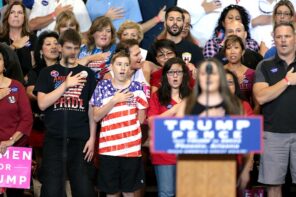There’s been a lot of discussion (in my Twitter feed, anyway) about religious support for America’s Problem Child. The sentiments run in two general camps: that Trump leads with white religious voters is disgusting, and that it proves that he’s in a good position to win on November 8th.
The first assertion—whatever you think of the value judgment—needs some qualification, and the second is pretty much wishful thinking at this point. Here’s what you need to make sense of the religious vote so far.
PRRI has expanded into more secular-based polling, but they still do good work with religious voters. They recently released a meta-analysis of four of their polls between late September to mid-October, with results as follows:
Not surprisingly, Trump’s strongest support comes from white Evangelicals and his weakest from Hispanics and African-Americans. We’ll talk about the minorities in a minute. Here, let us notice that while Evangelical support for Trump is overwhelming, he’s actually running quite a bit behind Mitt Romney’s 79% and even John McCain’s 73%. He’ll still win the demographic handily, but it won’t do him much good. Trump needs to improve on Romney’s scores with white voters in order to keep up with demographic changes in the US. That is, the nation is becoming steadily browner, and Trump, racist and xenophobic to the end, has dug himself a deep hole with that segment. Where else could he get the votes he needs? With white Evangelicals, who are consistently among the GOP’s core voters. But they’re not behind the Republican nominee like they used to be, which is part of the reason states like Georgia, North Carolina, and Texas are as close as they are.
Other polling bears out Trump’s weakness with Evangelicals. The Barna Group released a survey in mid-October that showed him leading Clinton among evangelicals (Barna’s spelling) 55-2. That sounds good, but the Barna definition of “evangelical” is fairly restrictive, more like what most of us would call “fundamentalists.” Among the broader “born-again” segment, Trump still leads by eighteen points, 49-31. But then there’s this:
Like her GOP opponent, Clinton claims the allegiance of several faith segments. Among them are notional Christians (i.e., people who consider themselves to be Christian but are not born again – the largest of the three Christian-oriented niches, constituting a segment she leads by a 48% to 36% margin); people aligned with non-Christian faiths (among whom she has a 37% to 30% lead); atheists and agnostics (61% to 18%); and Catholics (45% to 35%).
What’s driving Trump’s weakness with religious voters? A tremendous split by gender:
An admittedly unscientific poll by the Wheaton College student paper shows similar results: Trump barely wins men 32-30, but Clinton romps among women, 51-22.
The most important numbers may be still to come, however. PRRI looks to be releasing new information on the Catholic vote on Halloween, a number which often closely tracks the final total of overall voters. It’s also a number that varies quite a bit by the racial breakdown. While Trump wins white Catholics 48-41, he gets absolutely crushed among Hispanics, 84-12. A few back-of-the-envelope calculations put us firmly in “Holy shit” territory. Even assuming a generous 50-50 split of black, Asian, and other Catholics, Clinton comes out ahead something like 56-36.
It’s highly unlikely the race will be that much of a blowout among Catholics, much less Americans overall. Still, strong turnout from Hispanic voters could do serious damage among the religious support Trump needs to win. Even a ten-point lead among Catholics would put Clinton over the top in a genuine Democratic wave.
And whatever the results for 2016, the longer-range ramifications of Trump’s candidacy are even more troubling for the GOP. It’s often been noted that Trump is turning minority voters more firmly against the Republican party, an alliance that’s likely to endure. What’s less remarked upon is what a gender-based split among religious voters would do. If the usual Democratic gender gap begins to replicate itself among conservative white women, it will deny Republicans support among a swing vote (Catholics) and perhaps even their base (Evangelicals and Mormons). That’s a real possibility: Hillary Clinton is a uniquely controversial candidate. A Democratic nominee more acceptable to Evangelical women matched up against a Trumpist candidate could turn today’s 66% Evangelical support into 2024’s 55%—or worse.
If 2016 has taught us nothing else, of course, it’s that anything could happen. Even as I wrote this post, FBI Director James Comey launched a bombshell by announcing the agency was examining previously-unreleased emails from Hillary Clinton’s tenure at the State Department.
Still, between the browning of Catholicism, increasing secularization, and a possible rift in the Evangelical vote, I wouldn’t want to be in a Republican religious strategist’s shoes this year.
Update 10/31: PRRI released a teaser on their analysis of the Catholic vote this morning, showing Clinton up 51-40. By way of comparison, Obama won Catholics 50-48, and the national vote 51-47. That in a year when white Catholics were much less friendly to the Democratic nominee, and the Catholic vote was less Hispanic.
Given the nuttiness of this year, I’m reluctant to go too far out on a limb, but it’s sure starting to look like a Democratic wave.







